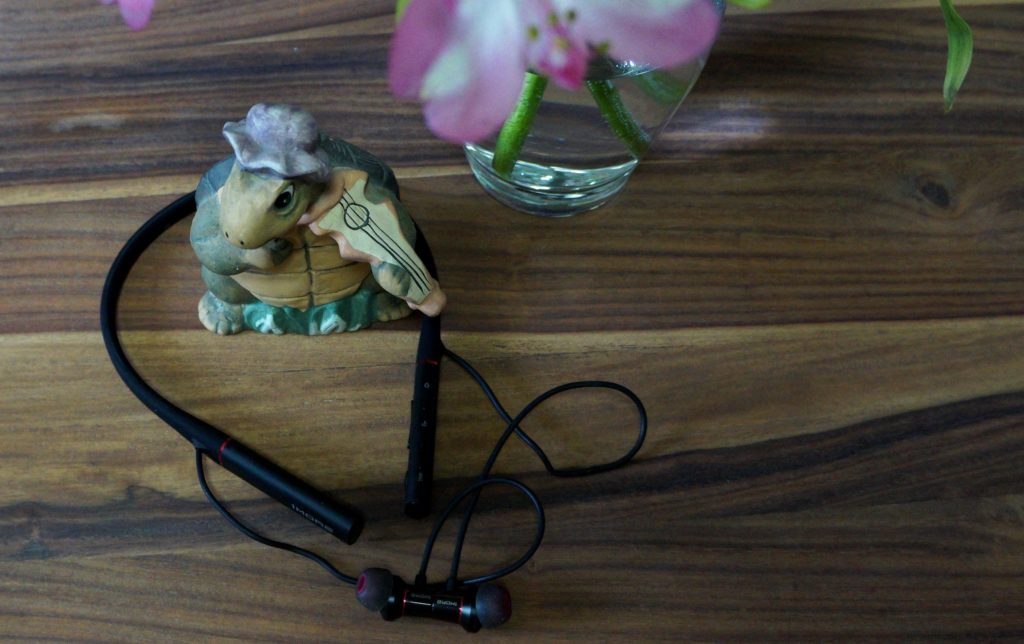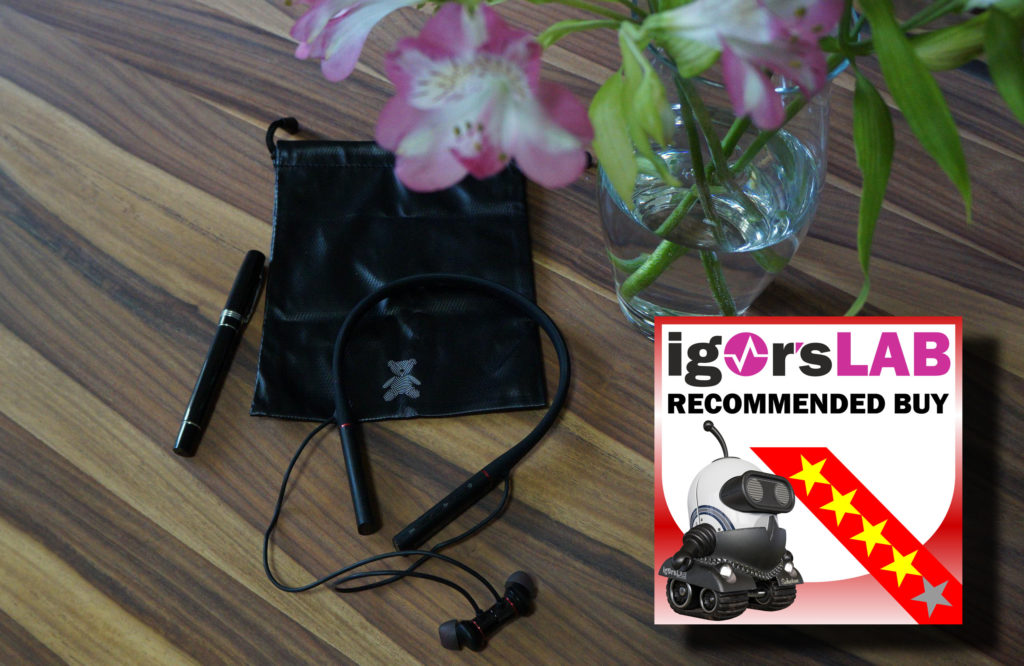I still have difficulties with the measurement of in-ears in the laboratory, because without adapted equipment such things quickly become a farce. Currently I still have to rely on my (critical) hearing, but I will avoid the usual verbal clouds as much as possible. What I was absolutely satisfied with was the sensitivity and level stability. So there are plenty of reserves for the next Corona demonstration. Let’s get straight on to the subjective assessment of things and leave the measurement curves aside for the time being. The assessment is based on the use out-of-the-box with changed (and thus adapted) silicone plugs from the 1More range.
Bass reproduction
Test the deepest bass in the subcontraoctave (16.4 Hz to 32.7 Hz) with a recording of Bach’s Toccata and Fugue in D minor (19 and 25 Hz) and the Festival Overture 1812 by Tchaikovsky (10 Hz and 12.5 Hz). The same applies to the lower ranges of the contraoctave (32.7 to 65.4 Hz). The big bass drum (kick drum), which is a welcome companion in underground music and is usually played at about 55 to 60 Hz is tuned, this assessment is then rounded off.
Without ANC the bass is already relatively low but not too fat. The low bass is cleanly perceptible right down to the very bottom, even the subcontraoctave can play along. This sounds amazingly mature and very dry balanced, never tending to booming but indicating an almost raven black overall feeling. If you want much more pressure here, all you have to do is activate ANC. Why you generate a separate bass profile for ANC, I can’t explain with logic, but everything becomes even fatter and more fundamental. You can like it, but it’s almost too much for me.
Admirable, especially without ANC, is the almost stoic-looking level stability of the two large membranes. The transient response is very good and you will certainly enjoy the very well contoured bass reproduction, which does not distort anything and does not push anything “upwards” and provoke mud.
The upper bass up to 150 Hz, which also contains the great octave (65.4 to 130.8 Hz), contains the basic voice frequency of the male voice and is very important for the natural reproduction of male vocals.
This area also sounds balanced and natural without ANC, but with activated ANC it sounds almost too greasy. In both cases the male vocals are reproduced rather warm and not too concise. The instruments are hardly falsified, but with activated ANC they weaken a bit in absolute presence and lose some of their contour. Overall, the resolution is very good and allows orchestral pieces, rock, pop and jazz of all colors to perform quite well. It’s important to use the right earplugs and to make sure that they are really clean, otherwise you’ll get acoustic mud, which of course generally also applies to the low bass and the tonal upper house.
Midrange
The lower mids (also fundamental range) are around 150 to 400 Hz. Together with the already mentioned upper bass, this range plays a very important role for the subjectively felt warmth or Fullness of the sound image. The basic voice frequency of female voices can be found in this range.
Without ANC there is nothing to complain about, but it gets noticeably cooler in the acoustic House of Commons. Nothing gets analytical, but it is draughty and lacks the often desired warmth, especially on female vocals. When ANC is activated, this restraint turns into a happy cuddling round by the fireplace. The sound gains extreme warmth and fullness and it becomes almost homely warm. Both votes will surely find their friends, although the variant with ANC seems to be much more compatible with the masses.
The upper mids between 400 Hz to about two KHz contain a mark at one KHz, which is still used as a reference for many measurements. Unfortunately, this is also often noticeable with cheaper devices, as the manufacturers often try to overemphasize this frequency. This area also plays a not insignificant role in gaming, and a balanced reproduction contributes not insignificantly to a good spatial resolution.
The stage and the subjectively perceived quality of the spatial resolution are on a very high level, which is certainly due to the price and the execution. An orchestra appears (purely subjectively) to be set up in a wide range and it is possible to localize individual instruments very clearly and unambiguously at different overall levels. Voice reproduction is not affected in this area, no matter how many sources are mixed. In terms of spatiality, ANC Off is ahead of ANC on, but the differences are not as extreme as the completely contrary basic tuning in this area would suggest.
High frequency range
Between two and about 3.5 KHz, the human ear is most sensitive, especially since this range of lower frequencies is responsible for the good overtone reproduction of the human voice. This frequency range is in fact decisive for the recognition of a voice or an instrument; in this context one also speaks of the respective tone colour.
The reproduction in this area is also free of criticism and the speech intelligibility and the quality of the vocals are excellent. Contour and differentiation are good, which is certainly good for the listeners. It almost doesn’t matter if you have ANC on or off, because the foundation changes, but this sounding leaves the lower treble range largely untouched.
The medium heights (3.5 to six KHz) decide whether speech reproduction is successful or unsuccessful as a whole, because the S and sibilants fall into this range. The upper heights then reach up to approx. ten KHz to go to super high frequencies.
Tweeter and super high frequencies are very dominant, but sibilants and breathing sounds are still and thankfully not brought too far forward. It is best to call it “crispy”, i.e. rather crispy, because it neither becomes metallic nor rattles. Was a little sensitive at peak heights, he still copes with it quite well, even if he probably has to get used to it. But even he will be able to live with it. The super high tone is noticeably present and rounds off brass and electronically generated sound structures very pleasantly towards the very top.
Summary and conclusion
Optically and haptically everything is in the green area, the electrical parameters up to the battery and the charging or Running times are right and also match the price. Codecs such as AAC and LDAC are a nice feature that good listeners don’t want to miss, but of course there is some praise for that. Otherwise I would probably not have recommended buying it.
The passive insulation against the outside world is certainly not bad, but the ANC is better when it comes to suppressing the outside world very effectively. The wind noise suppression in a special ANC stage makes the four built-in microphones react less sensitive, which interestingly also leads to a lower background noise, but does not influence the sound as extremely as the activated maximum ANC level. Then you notice a completely different tuning behavior of the headphones.
Which interpretation one prefers then is of course very subjective. I’m not judging. Each variety is not bad in its own way. By the way, the headphones radiate quite clearly to the outside due to the half-open principle of the drivers, which could annoy a seat neighbour. You must always be aware of this when choosing the volume level. Soundwise, these headphones are almost frighteningly good for the price.
At least when it comes to my acoustic preferences. Depending on the ANC position, you can choose between dry as hell and cool or deep as hell and warm. Something like smoked tofu from the refrigerator against a hot plate of meat or the calorie-reduced Imke-Dörte against chubby granny Hilde in Gutbürgerlich at a cooking duel. So there is something for everyone and all genres. Enjoy!

































Kommentieren